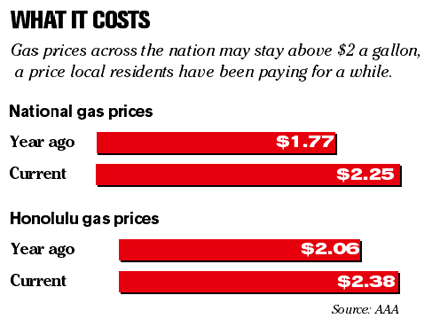
Better get used to it
Those looking for pump prices
to retreat below $2 are out
of luck, an official says
WASHINGTON » There's pump shock at every corner gas station, with prices well over $2 a gallon and still rising. And the government says you better get used to it.
The Energy Department projects high gasoline prices and $50-plus crude oil at least through next year as producers struggle to keep up with demand.
The department said yesterday it expects gasoline prices to average $2.35 a gallon nationwide next month, the dawn of the heavy summer driving season. Motorists paid an average of $2.22 a gallon last week, 44 cents more than a year ago.
If anyone thinks prices will dip below $2, once a benchmark rarely seen, they're mistaken, says Guy Caruso, head of the Energy Information Administration, the DOE's statistical agency.
Caruso said the forecast is for prices to average $2.28 a gallon through September and remain high after that, well into 2006, mainly because of lingering high crude oil prices and growing demand. He said crude prices, which briefly reached $58 this week, are likely to stay above $50 a barrel well into next year.
Ironically, just as the federal officials were talking about higher prices, crude tumbled nearly $2 a barrel to just over $54 a barrel and gasoline futures fell nearly 11 cents before slightly rebounding yesterday on the New York Mercantile Exchange.
Will that have any impact on prices at the pump?
"Probably not," said Phil Flynn, senior market analyst at Alaron Trading Corp. in Chicago.
"We're in a new era of high gas prices. The economy is strong and people don't care as much as they did. It's kind of weird," Flynn said in a telephone interview. "The shock value of $2 gasoline has gone away. It's a part of life. How long that can go on we don't know."
In fact, motorists grumbling about high fuel costs might be heartened by the fact that, in today's dollars, gas cost $3.15 a gallon when fuel spiked in 1981 because the Iran-Iraq war affected production in both countries.
At the core of today's high prices is tight supply -- or the expectation of it just around the corner -- at a time of and growing demand for both crude and gasoline, government and private analysts said.
"You've got demand forecasts that are clearly going up," says John Felmy, chief economist for the American Petroleum Institute, the trade group for large oil companies. He said refineries are running all-out to meet growing demand.
Clearly motorists aren't easing off the roads.
The Energy Information Administration reported yesterday that gasoline demand for this summer is projected to be 9.3 million barrels a day, a 1.8 percent increase over last summer, and the highest on record.
"There is very little spare (production) capacity," said Caruso, referring both to global crude oil markets and U.S. gasoline production.
While the government reported this week that U.S. gasoline and crude inventories were significantly higher than a year ago at this time, those statistics may be misleading. Because of more expected demand the amount of oil in terms of days' supply is below historic levels and is expected to remain so through 2006, EIA analysts predicted.
People are using more gasoline for a variety of reasons: more people of driving age, motorists driving more miles, a rebounding economy and an overall decline in automobile fuel economy, according to the EIA.
"We believe driving is not easily changeable for most people," said Geoff Sundstrom, a spokesman for the automobile group AAA.
 |
[News] [Business] [Features] [Sports] [Editorial] [Do It Electric!]
[Classified Ads] [Search] [Subscribe] [Info] [Letter to Editor]
[Feedback]
